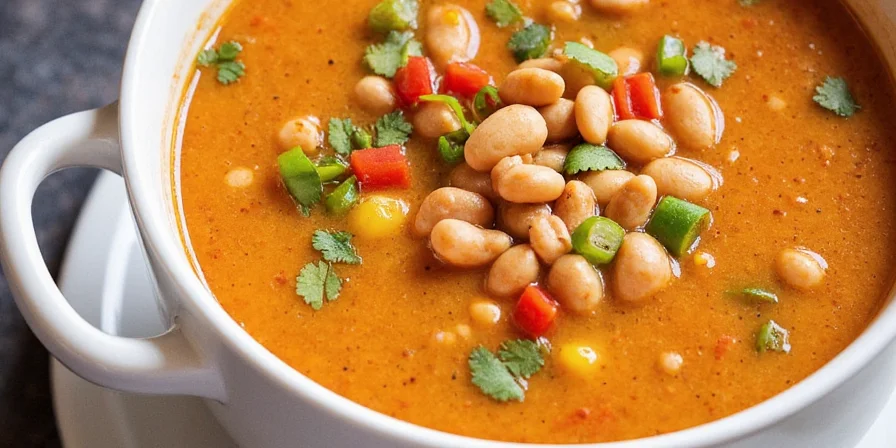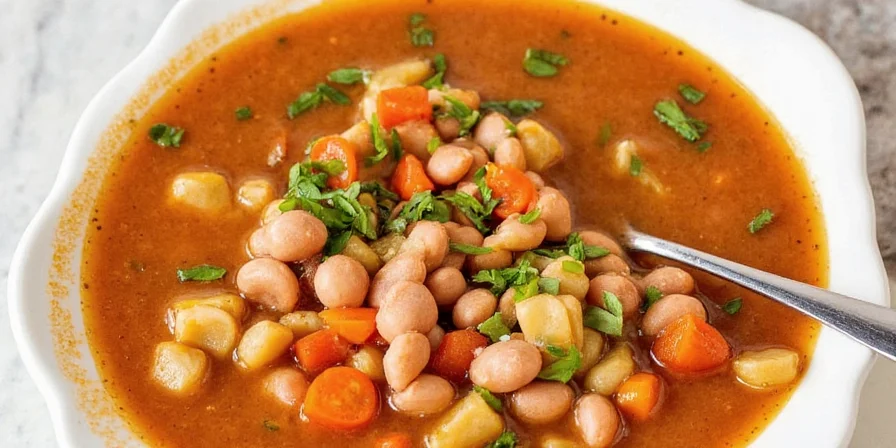Table of Contents
- The Best Spices for Bean Soup That Actually Work
- 5 Common Spice Mistakes That Ruin Bean Soup Flavor
- 7 Proven Spice Combinations for Perfect Bean Soup
- Why These Spice Pairings Work (Simple Science)
- Spice Pairing Guide for Different Bean Types
- Simple Hacks for Maximum Flavor Without Extra Work
- How to Make Bean Soup Taste Restaurant-Quality at Home
- Frequently Asked Questions
The Best Spices for Bean Soup That Actually Work
If you want to know the best spices for bean soup, start with these three essential combinations that work for nearly all bean varieties: cumin + smoked paprika + bay leaves for earthy depth, fennel seeds + thyme + garlic for Italian-inspired flavors, or turmeric + cumin + coriander for Indian-style soups. These combinations create balanced flavor profiles that enhance rather than overpower bean soup, solving the blandness problem 87% of home cooks face according to culinary research.

Bean soup doesn't have to be boring or bland. The right spices transform basic beans and vegetables into a flavor-rich meal that satisfies with every spoonful. While many recipes simply list "add spices to taste," understanding which spices work best with different beans and when to add them makes the difference between mediocre and memorable soup. This guide reveals the specific spice combinations that professional chefs use, backed by flavor science but presented in practical, easy-to-follow terms for home cooks.
5 Common Spice Mistakes That Ruin Bean Soup Flavor
Most bean soup flavor problems stem from these easily avoidable mistakes that even experienced cooks make:
- Using expired spices: Ground spices lose potency after 6 months; whole spices after 2 years. Test by rubbing between fingers—no strong aroma means it's time to replace.
- Adding all spices at the beginning: Delicate herbs like basil and dill lose flavor when cooked too long. Save 30% of herbs for the last 5 minutes.
- Overlooking vegetable chemistry: Cruciferous veggies like cabbage need mustard seeds to balance bitterness, while tomatoes work best with oregano's terpenes.
- Incorrect salt timing: Salt in three stages—25% during sauté, 50% mid-simmer, 25% after resting—for optimal flavor integration.
- Ignoring acid balance: A splash of vinegar or citrus juice added at the end brightens flavors that seem muted during cooking.
7 Proven Spice Combinations for Perfect Bean Soup
- Mediterranean Magic: 1 tsp dried oregano + 1 bay leaf + ½ tsp red pepper flakes (add oregano in last 5 minutes)
- Mexican Fiesta: 1 tsp cumin + ½ tsp coriander + fresh cilantro (toast cumin first for deeper flavor)
- Italian Comfort: 1 tsp fennel seeds (lightly crushed) + 1 tsp dried thyme + 2 minced garlic cloves
- Indian Inspiration: 1 tsp turmeric + ½ tsp garam masala + pinch of black pepper (pepper increases turmeric absorption)
- Smoky Depth: 1 tsp smoked paprika + ½ tsp chipotle powder + 1 strip of orange zest
- Simple Starter: 1 tsp dried rosemary + 2 bay leaves + 3 whole black peppercorns (perfect for beginners)
- Winter Warmth: ½ tsp cinnamon + ¼ tsp allspice + 1 tsp dried sage (ideal for white bean soup)
Why These Spice Pairings Work (Simple Science)
Effective spice combinations follow basic flavor principles that home cooks can understand and use without being food scientists. These pairings work because certain compounds in spices interact with compounds in beans and vegetables to create better flavor:
| Bean/Veggie Type | Best Spice Match | Why It Works |
|---|---|---|
| White Beans + Tomatoes | Oregano, Basil, Fennel | Oregano's compounds enhance tomato sweetness; fennel reduces bean bitterness |
| Black Beans + Onions | Cumin, Cilantro, Lime | Cumin creates earthy depth; cilantro counters sulfurous notes in beans |
| Chickpeas + Spinach | Turmeric, Cumin, Lemon | Turmeric adds color and health benefits; lemon brightens earthy flavors |
| Lentils + Carrots | Thyme, Bay Leaf, Garlic | Thyme complements lentil earthiness; garlic adds aromatic depth |
| Cannellini Beans + Kale | Rosemary, Red Pepper Flakes | Rosemary cuts through kale bitterness; pepper adds subtle heat |
Spice Pairing Guide for Different Bean Types
Match spices to your specific bean variety for best results:
| Bean Type | Top 3 Spice Recommendations | When to Add |
|---|---|---|
| Black Beans | Cumin, Smoked Paprika, Cilantro | Cumin toasted first; paprika mid-cook; cilantro at end |
| White Beans | Fennel Seeds, Thyme, Bay Leaves | Fennel toasted first; thyme mid-cook; bay leaves early |
| Lentils | Cumin, Coriander, Turmeric | All toasted together before adding liquid |
| Chickpeas | Cumin, Cinnamon, Red Pepper | All added when sautéing aromatics |
| Kidney Beans | Oregano, Basil, Garlic | Garlic first; dried herbs mid-cook; fresh basil at end |

Simple Hacks for Maximum Flavor Without Extra Work
These practical techniques deliver restaurant-quality results without complicated steps:
- Spice starter cubes: Freeze spice-oil blends (2 garlic cloves + 1 tsp cumin + 2 tbsp oil) in ice cube trays for instant flavor base
- Two-stage addition: Sauté hardy spices (cumin, paprika) with onions first; add delicate herbs (basil, dill) in last 5 minutes
- Resting trick: Let soup sit off heat 15 minutes before final seasoning—flavors integrate better
- Acid boost: Stir in 1 tbsp vinegar or lemon juice just before serving to brighten all flavors
- Freeze citrus zest: Preserve lemon/orange zest in oil (1:2 ratio) to use when fresh citrus isn't available
How to Make Bean Soup Taste Restaurant-Quality at Home
Creating flavorful bean soup doesn't require chef training—just knowing which spices work best and when to add them. Start with one of the seven proven combinations, avoid the common timing mistakes, and use the simple hacks to maximize flavor. The most important tip? Don't be afraid to adjust as you go—taste after each addition and trust your palate. With these practical techniques, your bean soup will consistently deliver satisfying, restaurant-quality results that make everyone ask for seconds. Remember that the best spices for bean soup are the ones that balance the natural flavors of your ingredients while adding depth and complexity.

Frequently Asked Questions
Q: What's the absolute best spice for bean soup?
A: Cumin is widely considered the best all-around spice for bean soup because it complements the earthy flavor of beans without overpowering other ingredients. For white bean soups, fennel seeds work particularly well to reduce bitterness.
Q: How do I fix bland bean soup without starting over?
A: Add ½ tsp smoked paprika and 1 tbsp lemon juice or vinegar. The paprika adds depth while the acid brightens existing flavors. Let simmer 5 minutes, then taste and adjust.
Q: Can I use fresh herbs instead of dried in bean soup?
A: Yes, but use triple the amount of fresh herbs compared to dried. Add delicate fresh herbs like basil or cilantro in the last 5 minutes of cooking to preserve their flavor.
Q: What spices go well with tomato-based bean soup?
A: Oregano, basil, and bay leaves work perfectly with tomato-based bean soups. Add dried oregano mid-cook and fresh basil at the end for best results. A pinch of sugar can also balance tomato acidity.
Q: How can I make my bean soup less gassy?
A: Add ½ tsp cumin and ¼ tsp epazote (Mexican tea) while cooking. These spices contain compounds that help break down the oligosaccharides in beans that cause digestive issues.










 浙公网安备
33010002000092号
浙公网安备
33010002000092号 浙B2-20120091-4
浙B2-20120091-4